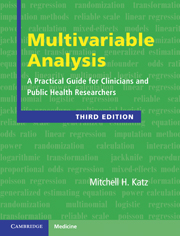Book contents
- Frontmatter
- Contents
- Preface
- 1 Introduction
- 2 Common uses of multivariable models
- 3 Outcome variables in multivariable analysis
- 4 Independent variables in multivariable analysis
- 5 Relationship of independent variables to one another
- 6 Setting up a multivariable analysis
- 7 Performing the analysis
- 8 Interpreting the results
- 9 Delving deeper: Checking the underlying assumptions of the analysis
- 10 Propensity scores
- 11 Correlated observations
- 12 Validation of models
- 13 Special topics
- 14 Publishing your study
- 15 Summary: Steps for constructing a multivariable model
- Index
- References
10 - Propensity scores
Published online by Cambridge University Press: 01 April 2011
- Frontmatter
- Contents
- Preface
- 1 Introduction
- 2 Common uses of multivariable models
- 3 Outcome variables in multivariable analysis
- 4 Independent variables in multivariable analysis
- 5 Relationship of independent variables to one another
- 6 Setting up a multivariable analysis
- 7 Performing the analysis
- 8 Interpreting the results
- 9 Delving deeper: Checking the underlying assumptions of the analysis
- 10 Propensity scores
- 11 Correlated observations
- 12 Validation of models
- 13 Special topics
- 14 Publishing your study
- 15 Summary: Steps for constructing a multivariable model
- Index
- References
Summary
What are propensity scores? Why are they used?
Propensity scores are calculations of the likelihood of a subject being in a particular treatment group, conditional on that subject's values on those independent variables thought to influence group membership. They are used to statistically adjust for differences between nonrandomized groups, typically for studies comparing different treatments.
To calculate a propensity score, you first identify the variables that influence treatment group membership, including demographics, disease severity, and characteristics of the treatment system (e.g., physician specialty, hospital, etc.). These variables are entered into a model (typically logistic) estimating the likelihood of treatment group membership. This model yields a score for each subject; the score is the estimated likelihood of being in one group versus the other, conditional on a weighted score of that subject's values on the set of independent variables used to create the propensity score.
DEFINITION
Propensity scores are the likelihood of a subject being in a particular treatment group, conditional on that subject's values on those independent variables thought to influence group membership.
Once calculated there are different ways you can use propensity scores. You can include each subject's propensity score in your multivariable model as an independent variable. Or you can use this score to individually match subjects with different treatment assignments but an equal likelihood of being in a particular group and assess the outcome using a matched analysis (Section 11.1). Alternatively you can assess the likelihood of outcome within quintiles of the propensity score.
- Type
- Chapter
- Information
- Multivariable AnalysisA Practical Guide for Clinicians and Public Health Researchers, pp. 180 - 184Publisher: Cambridge University PressPrint publication year: 2011



